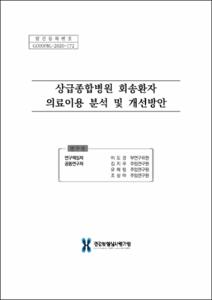상급종합병원 회송환자 의료이용 분석 및 개선방안
- Type
- Research report
- Issued Date
- 2020-12
- Abstract
- Objective: This study aims to examine health service use of returned patients from tertiary hospitals that participated in the pilot
implementation of referral and return program, and to produce improvement measures for the program.
Method: To understand health service use after being returned from a tertiary hospital, available returned patient-returned diagnosis episodes were collected by connecting treatment and return database and health service use in claims data. Patients who recorded 'return claim' from tertiary hospitals were tracked for type of service used, whether they used the returned hospital or partnership institution, etc. In addition, because adequate follow-up treatment is critical after being returned, readmission rate and treatment persistency of diabetics were analyzed to assess level
of care after being returned. To learn more about actual practice and collect opinions of working level, paper survey was conducted to staff at
medical cooperation center in tertiary hospitals and person in charge of return and referral at general hospitals, hospitals, and clinics.
Result: 39% of returned patients received the first medical service after the return from tertiary hospitals, and 61.0% received it from a general hospital or a lower level institution. When we factored in type of return (inpatient/outpatient) and type of service(inpatient/outpatient) after the return, 7.9% of inpatient return cases used tertiary hospitals and 72.7% used a general hospital or lower level institution. On the other hand, outpatient return cases showed higher use of tertiary hospitals. In particular, patients who were returned to a lower level institution as an outpatient after being admitted to a tertiary hospital showed 69.9% of tertiary hospital outpatient visit rate within 180 days from return. To assess level of management of patients after the returned, we observed readmission rate and treatment persistency of diabetics. Readmission rate and treatment persistency of diabetics was slightly higher among patients, who went back to the general hospital or lower level institution they were returned to, under certain condition. However, the result was not consisently showed under other conditions. The paper survey results suggests that there is a need to improve patients' awareness about return and provide encouragement measures. Information management system
of return hospitals and clinics was recommended as well.
Conclusion: Analysis of medical service use after return showed that many patients who returned from a tertiary hospital continued to receive
treatment from a tertiary hospital and did not move to a general hospital or lower level institution. This phenomenon requires a practical measure
to return patients in a more effective way. There is a lack of process at tertiary hospitals for returned patients. Therefore, we should establish a re-use procedure, so only medically necessary patients will seek treatment at tertiary hospitals. To ease patients' unwillingness to be returned from
tertiary hospital, hospitals can explain the return process at the point of admission or outpatient visit. Also, to relieve anxiety among patients and
secure effective follow-up treatment, we need to build an information management system of return hospitals and clinics and to strengthen
communication among medical professionals by adding more human resources to medical cooperation center.
- Publisher
- 건강보험심사평가원
- Alternative Title
- Health service use analysis and improvement measures for returned patients from tertiary hospitals
- Table Of Contents
- 요 약 ------------------------------- i
제1장 서론 ------------------------------- 1
1. 연구 배경 ------------------------------- 1
2. 연구 목적 ------------------------------- 3
3. 연구 내용 및 방법 ------------------------------- 3
제2장 국내 선행연구 고찰 ------------------------------- 5
1. 진료의뢰·회송 시범사업 개요 ------------------------------- 5
2. 진료의뢰·회송 시범사업 효과평가 연구 ------------------------------- 7
제3장 상급종합병원 회송 현황분석 ------------------------------- 11
1. 분석 개요 ------------------------------- 11
2. 분석 결과 ------------------------------- 14
제4장 상급종합병원 회송 후 의료이용 분석 ------------------------------- 23
1. 분석 개요 ------------------------------- 23
2. 상급종합병원 회송 후 첫 번째 의료이용 현황 ------------------------------- 29
3. 상병별 회송 후 첫 번째 의료이용 분석 ------------------------------- 34
4. 의료이용 유형(입원/외래)을 고려한 회송 후 의료이용 분석 ------------------------------- 40
제5장 상급종합병원 회송 후 환자 관리수준 분석 ------------------------------- 47
1. 회송환자 관리 수준 ------------------------------- 47
2. 회송환자의 재입원율 ------------------------------- 49
3. 회송된 당뇨병 환자의 진료지속성 ------------------------------- 60
제6장 의료기관 대상 서면조사 ------------------------------- 67
1. 조사 개요 ------------------------------- 67
2. 상급종합병원 대상 조사 결과 ------------------------------- 68
3. 회송 받는 기관 대상 조사 결과 ------------------------------- 79
제7장 상급종합병원 회송 개선방안 ------------------------------- 87
1. 상급종합병원 회송관련 문제점 ------------------------------- 87
2. 상급종합병원 회송관련 개선방안 ------------------------------- 88
제8장 결론 및 제언 ------------------------------- 95
참고문헌 ------------------------------- 99
부 록 ------------------------------- 103
- Publisher
- 건강보험심사평가원
- Location
- KOR
- Citation
- 이도경 et al. (202012). 상급종합병원 회송환자 의료이용 분석 및 개선방안.
- 파일 목록
-
-
Download
 상급종합병원 회송환자 의료이용 분석 및 개선방안.pdf
기타 데이터 / 4.05 MB / Adobe PDF
상급종합병원 회송환자 의료이용 분석 및 개선방안.pdf
기타 데이터 / 4.05 MB / Adobe PDF
-
Items in Repository are protected by copyright, with all rights reserved, unless otherwise indicated.